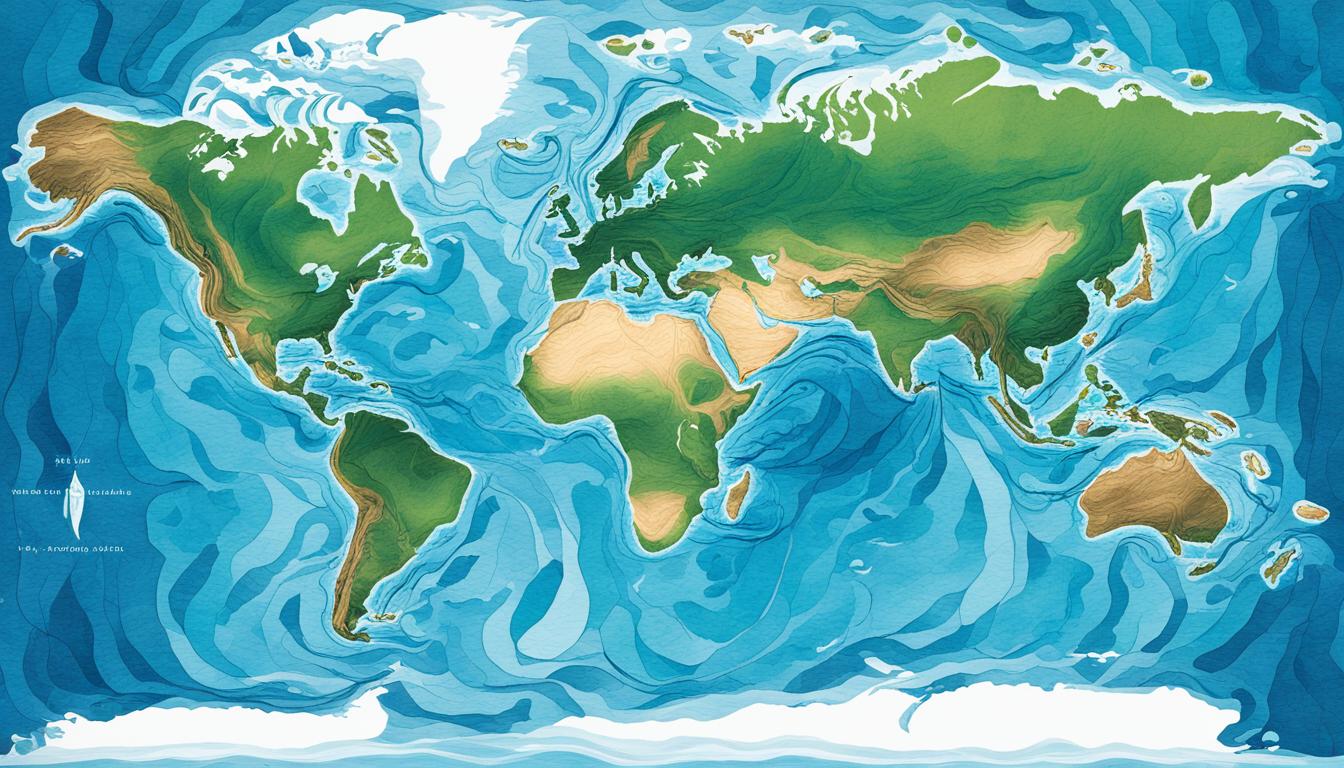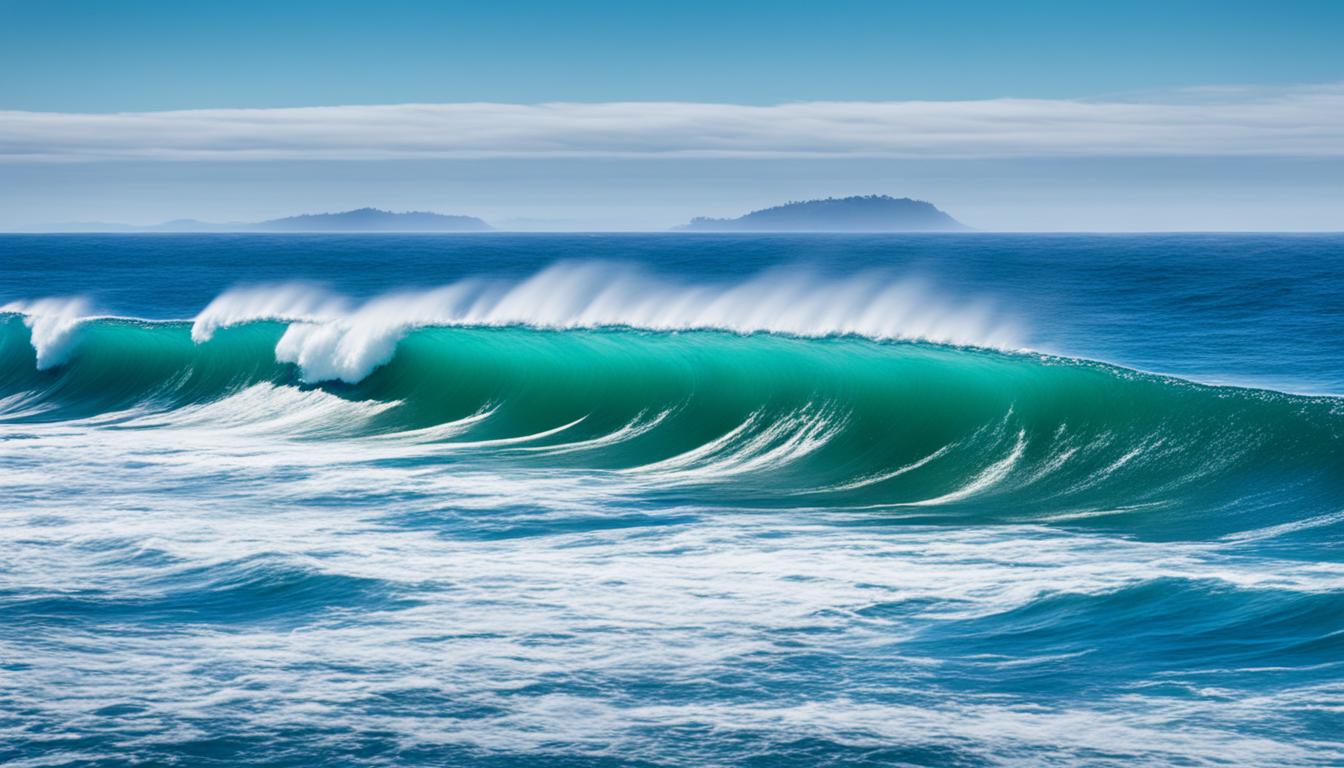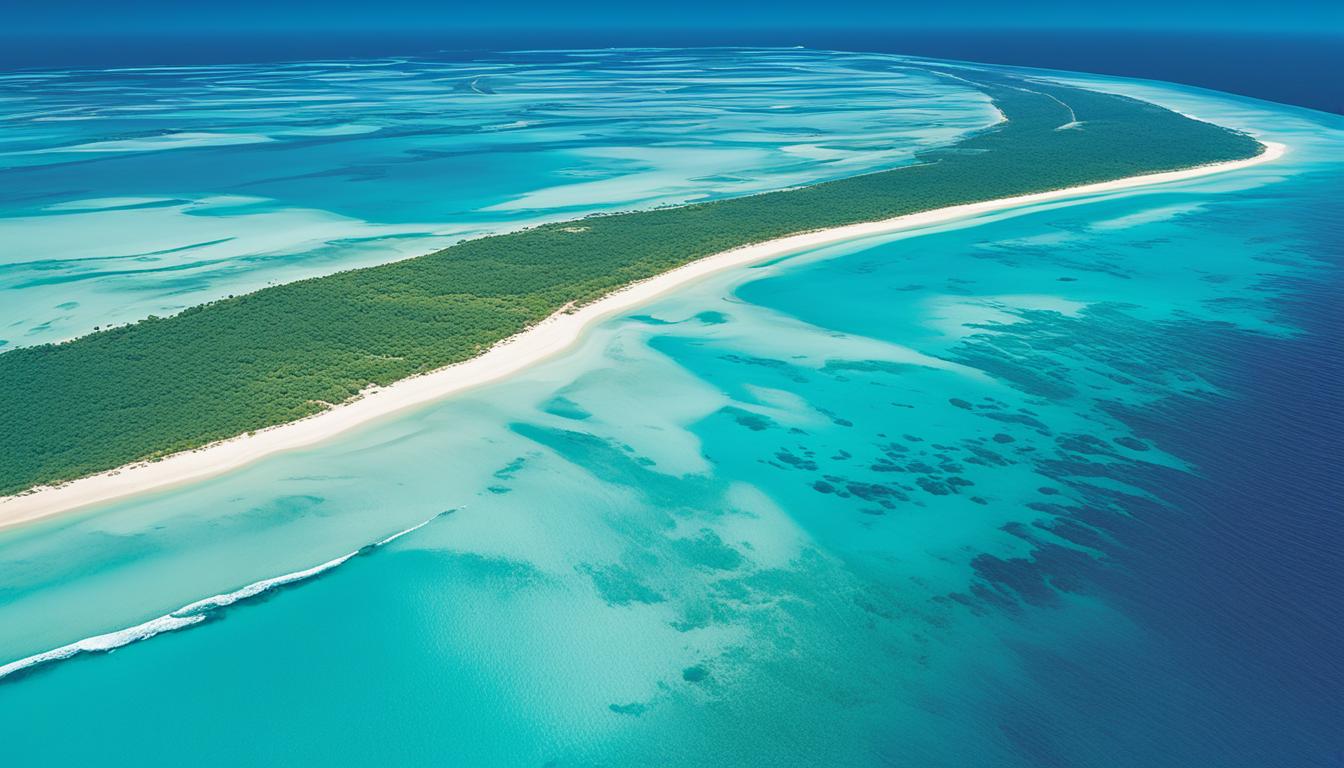The 7 Oceans of the World Map, The global ocean system stretches over 139 million square miles. It’s a vast network of water that shapes our planet’s climate and life. The seven major oceans make up a big part of Earth’s surface. They support countless life forms, including us.
This guide will take you on a journey through the seven oceans. You’ll learn about their unique features and why they’re important.
It’s perfect for anyone interested in geography, students, or just the curious. You’ll get a clear picture of the “what are the 7 oceans of the world map” and their role in our planet’s balance.
Key Takeaways
- The global ocean system comprises seven major oceans: the Pacific, Atlantic, Indian, Arctic, and Southern Oceans.
- Each ocean has distinct features, currents, and ecological characteristics that shape the local and global environments.
- Understanding the interconnectedness of the world’s oceans is crucial for addressing pressing issues like climate change, marine conservation, and sustainable resource management.
- Exploring the world’s oceans provides valuable insights into the Earth’s history, biodiversity, and the ongoing relationship between humans and the natural world.
- Continuous research and exploration of the oceans are essential for expanding our knowledge and developing effective strategies to protect these vital ecosystems.
Introduction to the World’s Seven Oceans
The Earth’s oceans are key to keeping the planet’s climate stable, supporting marine life, and helping shape human societies. Knowing about the 7 major oceans is vital for understanding geography and making smart choices on the environment, resources, and global issues.
Why Understanding the Global Ocean System Matters
The oceans are connected, forming a complex system that affects our lives in many ways. They give us food and resources, control the weather, and take in carbon dioxide. The health of our oceans directly links to the health of our planet.
Understanding the global ocean helps us make better choices on marine conservation, sustainable fishing, and fighting climate change. By learning about each of the 7 oceans, we value the ocean’s role in our world more deeply.
| Ocean | Area (sq km) | Deepest Point (m) |
|---|---|---|
| Pacific Ocean | 63,800,000 | -10,994 |
| Atlantic Ocean | 106,460,000 | -8,486 |
| Indian Ocean | 68,556,000 | -7,258 |
| Arctic Ocean | 5,440,000 | -5,550 |
| Southern Ocean | 20,327,000 | -7,235 |
Learning about the 7 major oceans helps us see the balance of our global ecosystem. This knowledge lets us make smart choices to protect our oceans for the future.
The Vast Pacific Ocean
The Pacific Ocean is the largest and deepest of the what are the 7 oceans on the world map. It stretches from the western coasts of the Americas to the eastern shores of Asia. This ocean has been key in global trade and human migration throughout history.
It’s over 36,000 feet deep at its deepest point. The Pacific Ocean is full of life, from colorful coral reefs to deep-sea creatures. Its currents and weather patterns affect the global climate, making it crucial to Earth’s ecosystem.
Explorers and seafarers have always been drawn to the Pacific Ocean. They seek its vastness and the chance to discover new things. From Ferdinand Magellan’s early voyages to today’s oceanographers, it continues to amaze and inspire.
We need to understand and protect our planet’s oceans, like the Pacific Ocean. It helps regulate the climate, supports marine life, and aids in global trade and communication. This shows why we must take care of this vast and dynamic ocean.
The Atlantic Ocean: Bridging Continents
The Atlantic Ocean stretches from the eastern coast of the Americas to the western coast of Europe and Africa. It’s the second-largest ocean in the world. This vast water body has greatly influenced our planet’s history and geography.
Major Features and Currents
The Atlantic Ocean is famous for its strong currents. These currents have shaped global climate and sea routes over time. The Gulf Stream is a key example, flowing from the Caribbean Sea to the eastern U.S. coast and across the Atlantic. It warms Western Europe’s climate.
Other important currents include the North Atlantic Drift, the Canary Current, and the Benguela Current. These currents are vital for the weather and temperature in the region. They affect maritime activities like shipping and fishing too.
| Major Current | Description | Impact |
|---|---|---|
| Gulf Stream | A warm, swift current flows from the Caribbean Sea to the eastern coast of the United States and across the Atlantic Ocean to Western Europe. | Influences the climate of Western Europe, making it milder than other regions at similar latitudes. |
| North Atlantic Drift | A branch of the Gulf Stream that flows across the Atlantic Ocean toward the British Isles and Scandinavia. | Plays a crucial role in regulating the climate of Northern Europe. |
| Canary Current | A cold current that flows along the western coast of Africa, originating from the Atlantic Ocean. | Influences the climate and marine ecosystem of the region, supporting rich fishing grounds. |
| Benguela Current | A cold current that flows northward along the southwestern coast of Africa, originating from the Atlantic Ocean. | Plays a significant role in the region’s upwelling, which brings nutrient-rich waters to the surface and supports a diverse marine ecosystem. |
The Atlantic Ocean has deeply influenced the geography, climate, and maritime activities of the regions it touches. It’s a key part of the global ocean system.
The Majestic Indian Ocean
The Indian Ocean is the third-largest ocean, covering about 27 million square miles. It’s known for its warm waters and plays a big role in global trade and transportation. Countries along its coastlines rely on it a lot.
This ocean is a wonder of nature, part of the seven oceans on the world map. It stretches from Africa’s southern tip to Australia’s western coast. This has shaped the history, culture, and economies of nearby countries.
The Indian Ocean is full of marine life, from blue whales to colorful coral reefs. Its warm waters support many unique species. These species are important to the people who depend on the ocean for food and jobs.
But, the Indian Ocean faces big challenges like overfishing, pollution, and climate change. It’s vital to protect this ocean for the planet and the communities that depend on it.
Exploring the Indian Ocean shows us our duty to protect its ecosystems. We must work to keep it healthy for future generations. By understanding its importance, we can help preserve it and support sustainable development in the areas it touches.
The Icy Arctic Ocean
The Arctic Ocean is the smallest and shallowest of the world’s oceans. It’s located at the northernmost point of the globe. This icy ocean is known for its ice-covered surface and the diverse marine life that thrives in its cold, nutrient-rich waters.
Impacts of Climate Change
The Arctic Ocean is very vulnerable to climate change. As global temperatures rise, the melting of sea ice is a big problem for the region’s ecosystems and indigenous communities. This rapid change is causing big problems, both locally and globally.
- Declining sea ice cover is disrupting the delicate balance of the Arctic’s marine food web. This threatens the survival of iconic species like polar bears, seals, and walruses.
- Melting permafrost is releasing stored greenhouse gases. This makes climate change worse and contributes to a cycle of environmental damage.
- Indigenous communities that have relied on the Arctic for generations are losing their traditional ways of life. The region they call home is changing dramatically.
We need to understand and address the global effects of climate change. The Arctic Ocean shows us how fragile our planet’s ecosystems are. By seeing how the world’s oceans are connected, we can work towards a sustainable future for everyone.
“The Arctic is the barometer of the planet. What happens in the Arctic doesn’t stay in the Arctic – it affects us all.”
– Enric Sala, National Geographic Explorer-in-Residence
What are the 7 Oceans of the World Map
Our planet is covered by seven oceans, each playing a key role in our world. From the vast Pacific to the icy Arctic, these oceans shape our climate, support trade, and maintain marine life.
The seven oceans on the world map are:
- Pacific Ocean
- Atlantic Ocean
- Indian Ocean
- Arctic Ocean
- Southern Ocean
- Weddell Sea
- Ross Sea
The Pacific, Atlantic, Indian, and Arctic Oceans are well-known. But the Southern Ocean and the Weddell and Ross Seas are special too. They have unique features and environments.
| Ocean | Area (sq km) | Average Depth (m) | Bordering Continents |
|---|---|---|---|
| Pacific Ocean | 63,800,000 | 4,280 | North America, South America, Asia |
| Atlantic Ocean | 31,800,000 | 3,926 | North America, South America, Europe, Africa |
| Indian Ocean | 27,200,000 | 3,963 | Africa, Asia, Australia |
| Arctic Ocean | 5,400,000 | 1,038 | North America, Europe, Asia |
| Southern Ocean | 20,327,000 | 3,270 | Antarctica |
Knowing about the seven oceans helps us understand our global ocean system. This system is crucial for our world, affecting everything from weather to trade.
The Southern Ocean: Earth’s Final Frontier
The Southern Ocean, the world’s fourth-largest ocean, surrounds Antarctica. It’s known for its icy conditions. This ocean is key to the global climate and supports unique marine life.
This ocean stretches from Antarctica to the southernmost parts of the Atlantic, Pacific, and Indian Oceans. The Southern Ocean is a natural wonder. Its waters, driven by the Antarctic Circumpolar Current, move heat and nutrients worldwide. This affects weather and supports diverse marine life.
The Southern Ocean is home to a vast array of marine life, including:
- Antarctic seals, whales, and penguins
- Krill, a tiny crustacean that serves as the foundation of the Antarctic food web
- A variety of fish, including Antarctic toothfish and mackerel icefish
This region is also known for its unique oceanographic features, such as:
- The Antarctic Circumpolar Current, the world’s largest ocean current system
- The Antarctic Convergence is a zone where cold, northward-flowing Antarctic waters meet warmer, southward-flowing subtropical waters
The Southern Ocean is one of Earth’s last untamed regions. Scientists, explorers, and nature lovers are drawn to it. Its remote nature and climate change threats highlight its importance for our planet’s marine ecosystems.
“The Southern Ocean is a place of stark beauty, extreme conditions, and immense importance for the global climate and marine life. Exploring and understanding this final frontier is essential for the future of our planet.”
Ocean Exploration and Conservation
Exploring the world’s seven oceans has shown me the amazing work of explorers and researchers. They’ve uncovered the secrets of the Pacific and the icy Arctic. Their work has helped us understand the complex life that supports our planet.
But, this knowledge also shows how fragile our oceans are. Threats like overfishing, pollution, and climate change harm these vital places. We all need to work harder to protect the oceans for the future.
Protecting Marine Ecosystems
Oceans have diverse ecosystems, from colorful reefs to deep-sea vents. We can protect these by supporting sustainable fishing, reducing plastic, and fighting climate change. Everyone can help in this effort to save our oceans.
FAQs
What are the 7 oceans on the world map?
The 7 oceans on the world map include the Pacific, Atlantic, Indian, Arctic, Southern, and two smaller seas. These are the Weddell Sea and the Ross Sea.
Why is understanding the global ocean system important?
Oceans are vast and complex, crucial for the Earth’s climate and life. They support marine life and shape human societies. Knowing about the 7 major oceans helps us make better decisions on the environment and global issues.
What are the key features of the Pacific Ocean?
The Pacific Ocean is the biggest and deepest ocean, covering about 63 million square miles. It stretches from the Americas to Asia, affecting global trade and human migration.
What are the major features and currents of the Atlantic Ocean?
The Atlantic Ocean is the second-largest, stretching from the Americas to Europe and Africa. It’s known for currents like the Gulf Stream, which have shaped climate and trade routes.
What makes the Indian Ocean unique?
The Indian Ocean is the third-largest, with warm tropical waters and diverse marine life. It’s vital for global trade and transportation for coastal countries.
How is the Arctic Ocean being impacted by climate change?
The Arctic Ocean is the smallest and shallowest, located at the globe’s top. It has ice and unique marine life. But, climate change is melting its ice, threatening ecosystems and communities.
What is the role of the Southern Ocean in the global climate system?
The Southern Ocean surrounds Antarctica, with harsh conditions and unique life. It’s key to global climate patterns.
How are efforts to protect and conserve the world’s marine ecosystems?
Research and exploration show oceans’ importance for the planet and humans. But, they face threats from human activities. Protecting them is vital for our future.
Conclusion
The seven oceans of the world—namely the Pacific, Atlantic, Indian, Southern (or Antarctic), Arctic, and the newer recognition of the Southern Ocean as distinct—each play a crucial role in Earth’s climate, biodiversity, and human activity.
Understanding these oceans’ dynamics helps in addressing environmental challenges, managing resources, and conserving marine habitats.




